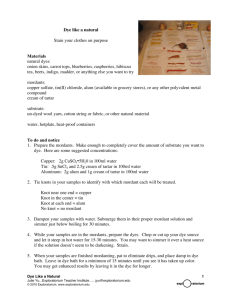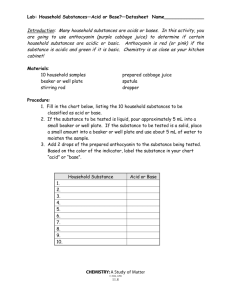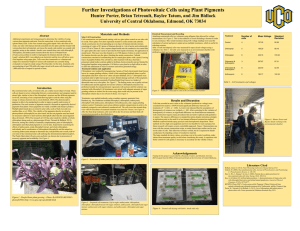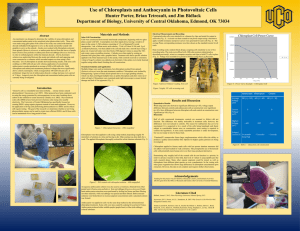Anthocyanin dyeing –Hibiscus
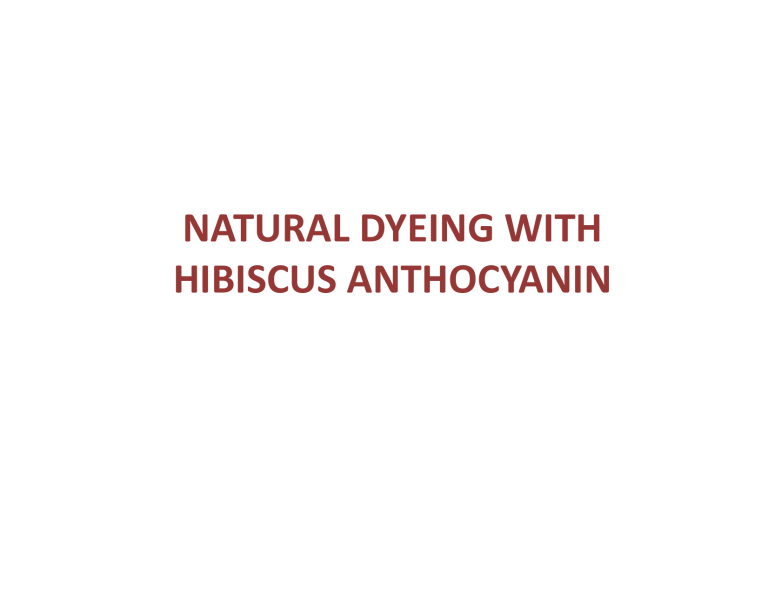
NATURAL
DYEING
WITH
HIBISCUS
ANTHOCYANIN
INTRODUCTION
Dye
It is any substance, natural or synthetic, used to color various materials.
A dye can generally be described as a colored substance that has an affinity to the substrate to which it is being applied.
Types of Dyes
Sources of
Natural Dyes
Substantive
Dye
Natural
Plant/
Vegetable origin
Synthetic
Mineral
Origin
Types of
Natural
Dyes
Insect/
Animal
Origin
Vat Dye
Mordant
Dye
Classification of Natural Dyes
On the basis of Chemical
Constituents
• Indigoid Dyes
• Anthraquinon
• Alpha ‐ Naphtha
• Flavones
• Dihydropyrans
• Anthocyanidins
• Carotenoids
On the basis of Mineral colorants
• Red color
• Blue Color
• Brown and Black Dye
• Yellow color
On the basis of Applications
• 1 Acid dyes
• 2 Basic dyes
• 3 Direct or substantive dye
• 4 Mordant dyes
• 5 Reactive dye
• 6 Disperse dye
• 7 Azoic dye
Advantages of Natural Dyes
1) Natural dyes have pharmacological effects and possible health benefits.
2) They are obtained from renewable sources.
3) Natural dyes cause no disposal problems, as they are biodegradable.
Dyes versus pigments
A dye binds to the substrate, but a pigment generally has no affinity for the substrate.
The major difference between dyes and pigments is solubility .
Dyes are usually soluble in water.
Pigments are generally not soluble in water, oil, or other common solvents.
NATURAL PIGMENTS
Natural pigments are highly colored substances found in living organisms, (i.e either in plants or in animals are known as plants and animals pigments) Natural pigments are good for use in the shower gel, bath bombs.
These pigments have good quality of bleed protectiveness in soap and these are also water dispersible.
But, these pigments don't have high intensity in light.
Kinds
of
Natural
Pigments
Plant pigment
Carotenoid
Pigments
Betalain
Pigments
Anthocyanin
Pigments
Anthocyanin Pigments
Greek ‐ anthos (flower) and kyanos (blue)
These are colored pigments and these are found profusely in plant kingdom. The colors imparted by these pigments are blue, red and purple. in flower, fruit, stem, leaves and root of plants. They soluble in water and generally occur in the aqueous cell sap.
Color ‐ Red, Purple and Blue
Source ‐ Red Cabbage, Strawberries, Grape Skin, Blueberries,
Raspberries
Color Pigments ‐ Cyanidin, Delphinidin, Malvidin, Peonidin.
Solubility ‐ Soluble in aqueous solutions
Stability ‐ Each pigment has different stability .
Brighter in lower pH range Becomes blue at higher pH
Other Properties ‐ Antimicrobial Properties, Antioxidant properties ,
Anti ‐ cancer properties
structure of Anthocyanin Pigments
Anthocyanins are derivatives of anthocyanidins which include pendant sugars. The common sugars found in anthocyanin are glucose, galactose and rhamnose. The different shade of the flower are due to the presence of some anthocyanin in different media (i.e. their acidic salts are red, alkali salts are blue and free anthocyanins are violet.)
STRUCTURE OF
ANTHOCYANIDIN PIGMENTS
Sugar free portion of anthocyanin
Anthocyanidin
Principle
of
Natural
Dyeing:
1.
Most natural dyes need both a plant extract and a mineral mordant to make a permanent color.
2.The
stronger the dye extract ‐ the more plant used ‐ the deeper the colour.
3.Mineral
(metal salt) mordants are always used in the same PROPORTION.
4.TIME
‐ TEMPERATURE ‐ CONCENTRATION are the variables involved in any chemical reaction.
Higher temperature means less time needed for dyeing, as does higher concentration of dyestuff.
Mordants
Mordants are those compounds which bind the natural dyes to the fabrics and prevent the color from either fading with exposure to light or washing out Hence mordant is a chemical which enables the fabric to take up the color of the dye.
Metallic salts, tannins and oils are also used as mordants.
Generally cotton mordanted with these mordants.
These mordant impart affinity for basic dye.
tannins
and
tannic
acid metal
salts
or
metallic
mordants oils
or
oil mordants
‐
Types of mordants
Pre ‐ mordanting
Post ‐ mordanting
Methods of mordanting
Meta ‐ mordanting
REVIEW OF LITERATURE
This literature review constitute 102 references from 1868 to 2009 , which is based on Natural dyeing by using Anthocyanin from various natural sources. This review also focus on the effect of mordants on natural fibers (i.e. colorfastness and washing fastness). The production and stability of anthocyanin is activated by antioxidant and U ‐ V radiation. Some latest literature survey are given below ‐
Shahina Waheed, Amina Alam (2006) explained the effect of mordants on color shade and color fastness of silk dyed with Kikar and Madder barks.
The silk fabric was dyed with aqueous extract of Kikar bark ( Acacia arabica [ A.
nilotica ]) and Madder bark ( Rubia cordifolia ) by using various metal sulfates as mordants.
Yoshiumi Kohno, Reina Kinoshita, Shuji Ikoma, et al.
(June 2009) gave stabilization of natural anthocyanin by intercalation into montmorillonite.
Stephanie Jolly (Feb 2009) proposed that Red Anthocyanin Pigments in Cabbage turn Color with Changes in pH. Red cabbage juice contains anthocyanin pigments that change color when mixed with alkaline or acidic ingredients
Hill D.J
(1998) told about the future for natural dyes.
The current status of the natural dye industry and potential market for textile dyed with natural dyed
Rakhi Shanker and Padma S.
Vankar (May 2006) proposed on dyeing cotton, wool and silk with Hibiscus mutabilis (Gulzuba) Cotton rose / belongs to family Malvaceae produces natural dye which has been used for dyeing textiles
Materials
Materials and method
Apparatus
Flowers of
Hibiscus rosa sinensis
Substrate
Natural dyes
UV ‐ Visible
Spectro ‐ photomet er
Rota vapor
Color scan
Machine
Cotton
Silk
Wool
Chemicals
Mordants
Methanol
Citric Acid
Tannic Acid
Alum
Copper sulphate
Potassium dichromate
Stannous chloride
Method
Pure Fabric Washing
Tannic Acid
Treatment for cotton
Mordanting
Dyeing
Visible spectrometry testing of
Anthocyanin
Removal of methanol from
Anthocyanin
L*a*b* values before and after fixing
Fixing with Citric
Acid
Extraction of anthocyanin from
Hibiscus rosa sinensis
Result and discussion
Identification of Extracted Methanolic solution of Anthocyanin pigment by Visible Spectroscopy
The Anthocyanin are characterized by two absorption bands ‐
Band I ‐ 475 ‐ 560 nm (Visible region)
Band II ‐ 275 ‐ 280 nm (UV region)
The actual color (Band I) depends on the number and position of hydroxyl and methoxyl groups.
The broad peak of Anthocyanin Pigment was observed at 516 nm wavelength which indicate that anthocyanin pigment fall in visible region with the absorbance 1.404
(as shown in figure)
Yield of Anthocyanin Pigment ‐ 5.195
%
Including moisture
L* a*b* values for Cotton dyed by Anthocyanin of Hibiscus rosa sinensis before fixing with
Citric Acid
Mordants L* a* b* C H Color % K/S values
Control
Alum
Copper sulphate
Potassium dichromate
Stannous chloride
41.977
41.971
40.535
41.986
37.344
40.230
40.116
38.290
19.505
19.512
‐
2.725
2.715
2.114
12.259
16.298
40.322
40.208
38.348
23.038
25.423
3.873
3.870
3.159
32.137
320.145
100
90.854
83.470
93.239
223.796
66.6939
60.5941
55.6693
62.1848
149.2585
L* a*b* values for Cotton dyed by Anthocyanin of Hibiscus rosa sinensis after fixing with Citric Acid
Mordants
Control
Alum
Copper sulphate
Potassium dichromate
L*
39.420
38.339
39.616
44.894
a*
25.990
21.490
24.127
8.501
b*
‐ 0.045
‐ 4.130
1.733
20.498
C
25.990
21.883
24.189
22.191
H
359.901
349.126
4.107
67.448
Color %
26.233
29.148
26.183
40.539
K/S values
17.4956
19.4397
17.4626
27.0372
Stannous chloride
37.711
18.418
‐ 11.851
21.901
327.254
149.351
99.6082
L* a*b* values for silk dyed by Anthocyanin of Hibiscus rosa sinensis before fixing with Citric Acid
Mordants L* a* b* C H Color % K/S values
Control
Alum
Copper sulphate
Potassium dichromate
Stannous chloride
46.318
46.537
46.411
46.577
44.295
29.48
29.841
27.96
20.291
19.248
‐
0.576
1.237
1.998
5.702
9.383
29.486
29.869
28.031
21.077
21.413
1.119
2.373
4.086
15.69
334.022
100
91.864
95.276
75.814
171.707
33.0538
29.6050
29.9003
28.5089
64.3137
L* a*b* values for silk dyed by Anthocyanin of Hibiscus rosa sinensis after fixing with Citric Acid
Mordants L* a* b* C H Color % K/S values
Control
Alum
Copper sulphate
Potassium dichromate
45.522
44.521
45.763
51.298
26.017
21.516
24.115
7.98
‐
‐
0.649
4.64
1.236
20.871
26.025
22.011
24.147
22.345
358.572
347.835
2.933
69.048
40.329
44.81
40.254
62.323
14.6310
17.5277
19.7643
27.4247
Stannous chloride
45.248
8.035
‐ 8.057
11.379
314.94
150.139
65.4133
L* a*b* values for wool dyed by Anthocyanin of Hibiscus rosa sinensis before fixing with Citric Acid
Mordants L* a* b* C H Color % K/S values
Controlled 37.957
23.886
2.04
23.973
4.88
100 74.9314
Alum
Copper sulphate
Potassium dichromate
38.935
40.472
40.467
24.77
22.316
12.878
5.706
12.404
12.985
25.419
25.432
18.288
12.967
29.055
45.219
298.585
260.679
270.091
223.7335
195.3306
202.3826
Stannous chloride
37.421
9.896
0.927
9.939
5.349
718.225
538.175
L* a*b* values for wool dyed by Anthocyanin of Hibiscus rosa sinensis after fixing with Citric Acid
Mordants
Controlled
Alum
Copper sulphate
Potassium dichromate
L*
38.666
40.002
42.759
42.06
a*
17.47
19.119
17.555
10.814
b*
5.196
9.119
19.226
17.031
C H
18.226
16.557
21.82
26.035
20.174
25.489
47.582
57.563
Color %
48.17
114.174
169.182
196.454
K/S values
36.0947
85.5523
126.7705
147.2058
Stannous chloride
38.254
10.515
2.916
10.912
15.493
889.6
666.655
The K/S values Of Different Fabrics
The mordant activity of the four cases for different fabrics after fixing possess following sequences:
In cotton ‐
Copper sulphate Control Alum
Potassium dichromate
Stannous chloride
In Silk ‐
Control
In Wool ‐
Control
Alum
Potassium dichromate
Copper sulphate
Stannous chloride
Alum
Copper sulphate
Potassium dichromate
Stannous chloride
conclusion
The large ‐ scale production of textile dyed with anthocyanin dye is a new concept of the textile industry.
Anthocyanin extract of Hibiscus rosa sinensis flowers yield shades with good fastness properties. and it is also clear from this study that anthocyanin pigment can very well be used as dye material giving primarily different shades of red.
The best color was obtained with stannous chloride and it gave good washing fastness also in terms of K/S values.
This better shade with Tin may also due to stable complex formation between anthocyanin and tin.
The development of shade and fixation of natural dyes on natural fibers depends on the use of mordants .
As the washing fastness was considerably good in anthocyanin dyed fabric (cotton, silk, wool).
It can be future color for consumers.
The dye has good scope in the commercial dyeing of cotton, silk for garment industry and wool for carpet industry.

